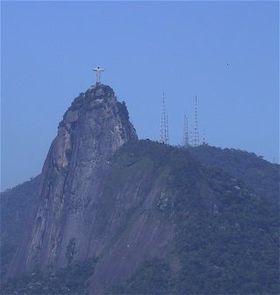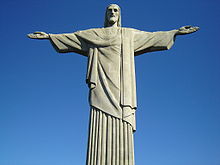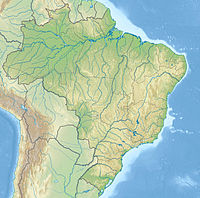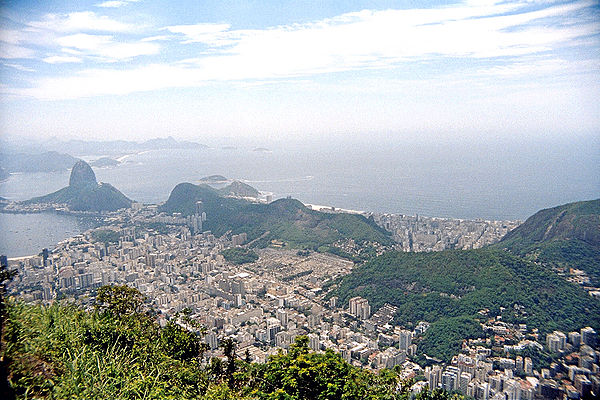- Corcovado
-
This article is about the mountain in Rio de Janeiro. For other uses, see Corcovado (disambiguation).
Corcovado 
Elevation 710 m (2,329 ft) Translation Hunchback (Portuguese) Location Rio de Janeiro,  Brazil
BrazilCoordinates 22°57′8.7″S 43°12′42″W / 22.952417°S 43.21167°WCoordinates: 22°57′8.7″S 43°12′42″W / 22.952417°S 43.21167°W Geology Type Granite  The statue of Cristo Redentor atop Corcovado
The statue of Cristo Redentor atop Corcovado
Corcovado, meaning "hunchback" in Portuguese,[1] is a mountain in central Rio de Janeiro, Brazil. The 710-metre (2,329 ft) granite peak is located in the Tijuca Forest, a national park. It is sometimes confused with nearby Sugarloaf Mountain
Corcovado hill lies just west of the city center but is wholly within the city limits and visible from great distances. It is known worldwide for the 38-metre (125 ft) statue of Jesus atop its peak, entitled Cristo Redentor or "Christ the Redeemer".
Contents
Access
The peak and statue can be accessed via a narrow road or by the 3.8 kilometre (2.4 mi) Corcovado Rack Railway which was opened in 1884 and refurbished in 1980. The railway uses two electrically powered trains, with a passenger capacity of 360 passengers per hour. The rail trip takes approximately 20 minutes and departs every half hour. Due to its limited passenger capacity, the wait to board at the entry station can take several hours. The year-round schedule is 8:30 to 18:30.
From the train terminus and road, the observation deck at the foot of the statue is reached by 223 steps, or by elevators and escalators. Among the most popular year-round tourist attractions in Rio, the Corcovado railway, access roads, and statue platform are commonly crowded.
Attractions
The most popular attraction of Corcovado mountain is the statue and viewing platform at its peak, drawing over 300,000 visitors per year. From the peak's platform the panoramic view includes downtown Rio, Sugarloaf Mountain, the Lagoa Rodrigo de Freitas (lake), Copacabana and Ipanema beaches, Estádio do Maracanã (Maracanã Stadium), and several of Rio's favelas. Cloud cover is common in Rio and the view from the platform is often obscured. Sunny days are recommended for optimal viewing.
Notable past visitors to the mountain peak include Pope Pius XII, Pope John Paul II, Alberto Santos-Dumont, German Sueiro Vasquez, Albert Einstein, and Diana, Princess of Wales. An additional attraction of the mountain is rock climbing. The south face had 54 climbing routes as of 1992. The easiest way starts from Park Lage.
The Corcovado is also a symbol of the Brazilian culture.
Geology
The peak of Corcovado is a big granite dome, which describes a generally vertical rocky formation. It is claimed to be the highest such formation in Brazil, the second highest being Pedra Agulha, situated near to the town of Pancas in Esprito Santo.
Popular culture
Corcovado is a famous bossa nova song written by Antônio Carlos Jobim in the mid-1960s. It is also mentioned in the Ben Harper song titled "Blessed to be a Witness". A song called "Corcovado" by João Romeu Ferraz also illustrates the grandiosity of the statue.
Corcovado is also a electronic house song by Ray Knox that became popular in late 2010.
Corcovado shows resemblance to the Modern Warfare 2 map Favela.[citation needed]

View of Rio de Janeiro from atop Corcovado — left: Sugarloaf Mountain (Pão de Açúcar); center: Copacabana beach. References
External links
Categories:- Mountains of Brazil
- Granite domes
- Rio de Janeiro (city)
Wikimedia Foundation. 2010.


